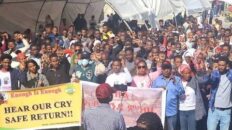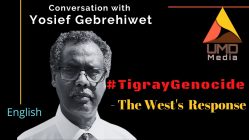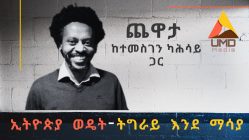Gebrehiwot Hailemariam*
August 4, 2024
The genesis of the Tigray People’s Liberation Front (TPLF) traces back to the popular revolt and uprising of 1942-43 against the imperial regime, known as the First Woyane Movement in Tigray. Although this uprising was crushed by imperial forces, it laid the foundation for the emergence of the TPLF in 1975, as an armed resistance group aimed at reviving the suppressed movement and fighting against the oppressive regime.
Many writers describe the TPLF as a political party founded on ethno-nationalism and Marxist ideology, which fought against the military dictatorship of the Derg from 1975 until 1991. After 17 years of bitter and protracted armed struggle, the party succeeded in overthrowing Mengistu’s regime in 1991. It is common for political parties to face internal crises in the post-war or post-conflict era, but what is crucial are the causes, course, and outcomes of these crises. Several scholars recognize that such crises are natural and widespread in political parties. A crisis typically arises from instability among individuals and groups due to existing interactions. Intra-party crises reflect an unstable condition within party leadership, often resulting from clashes over political goals, incompatible personal interests, and irreconcilable ambitions. Furthermore, these crises can lead to severe turmoil, extreme polarization, and deep distrust among leaders.
The TPLF’s internal crisis and fragmentation are not new in its political history. However, what’s significant is that these intra-party crises often seek resolution at the expense of the Tigrayan people. The party’s first major internal crisis occurred in 1969, shortly after its establishment, in an episode known as “Hinfishfish” or chaos. A similar crisis emerged in 1977-78, leading to a leadership struggle that saw Meles Zenawi rise as the party chairman, while Aregawi Berhe was demoted and eventually exiled. Another significant internal crisis unfolded in 1993, following the Ethio-Eritrean War, which ended with Meles Zenawi’s victory over Gebru Asrat.
A central aspect of the TPLF’s political history is its frequent internal crises, chaos, dissent, leadership splits, and factions. This paper aims to analyze the party’s contemporary internal crises and factionalism. While there are various theoretical frameworks available to study intra-party conflict, this paper focuses on using elite theory and realistic group conflict theory (RGCT) to investigate the TPLF’s internal factions.
According to Gaetano Mosca (1939), an Italian political scientist, journalist, and public servant credited with developing the elite theory and the doctrine of the political class, the central argument of elite theory is that political power is concentrated in the hands of a minority group, which carries out all political functions, monopolizes power, and enjoys the associated advantages. This theory posits that political power is centralized among a few individuals at the top of the political hierarchy. As a result, top party leaders often select candidates themselves, prioritizing imposition over democratic election, and personal interests over national interests.
The second relevant theory to this paper is the RGCT, articulated by Donald Campbell in 1965. This theory suggests that an excessive desire to control limited resources, military protection, and political power drives intergroup conflicts. The advantaged group seeks to maintain its hegemonic dominance over the disadvantaged group, while the disadvantaged group strives to break this domination and compete for power and resources. This dynamic leads to intergroup hostility, driven by conflicting interests, goals, and unhealthy competition for political power. The resulting struggle and competition inevitably create tension, chaos, and conflict, making crises unavoidable.
Following the Pretoria peace agreement, the TPLF has faced deep internal factions and crises. This paper will explore these internal divisions within the context of Tigray’s fragile political landscape. It is unfortunate that the TPLF’s leaders are focused on power struggles while neglecting urgent public issues such as peace, security, economic recovery, and reconstruction. The people of Tigray, already devastated by one of Africa’s deadliest genocidal wars, continue to suffer as the conflict evolves in different forms.
Initially, the Pretoria peace agreement was seen by the Tigrayan people as a beacon of hope, offering the possibility of resolving the consequences of the genocidal war and transitioning to sustainable peace and a new political chapter. However, Tigrayans now find themselves living in harsh conditions, with no security, no food, and no hope. The scars of the total war are visible across the region, creating wounds that urgently need healing and rehabilitation. Since the agreement, the problems facing Tigray have only become more complex and multifaceted.
The current TPLF leadership is deeply divided into two hostile factions, one led by the party’s chairman, Debretsion Gebremichael, and the other by his rival, Getachew Reda, who serves as the vice chairman of the party and president of the Tigray Interim Administration. Many Tigrayan elites agree that the TPLF has lacked a strategic leader with vision since the death of Meles Zenawi.
While the factionalism within the TPLF has historical roots, the current crisis appears to be unique and may have far-reaching consequences. The present leadership is operating in a post-genocidal war era, following the Pretoria peace agreement, and remains on the periphery of Ethiopian politics. Uncovering the true causes of the party’s internal divisions is challenging because these issues are not made public or accessible to the media. Moreover, the political culture of the TPLF traditionally does not permit independent media coverage or public disclosure of its internal decisions.
Some political analysts emphasize that the current rivalry between Debretsion Gebremichael and his team—including Alem Gebrewahid, the former general secretary of the party; Fetlework Gebregziabher; and Getachew Assefa, the former head of Ethiopia’s national security—versus Getachew Reda and his team—comprising General Tsadaqan Gebretenasy, the former Ethiopian chief of staff; Beyen Mekru, chief of EFFORT; and Redae Halefom, head of the communications office—primarily revolves around a struggle for power.
Following the Pretoria Peace Agreement, TPLF leaders engaged in prolonged meetings and intense Gemgam, sessions of criticism and self-criticism replete of accusation, attack, and blame. These extended and contentious meetings have led to increased polarization, fragmentation, dissent, and deepened crises within the party. This internal conflict has severely damaged the party’s structure, with both rival factions working diligently to expand their networks, build support, and consolidate their positions.
Veteran Tekelebrhan Araya, head of the Central Audit and Control Commission of the party, has confirmed that the TPLF is on the brink of collapse. He highlighted that the party is now teetering on the edge due to the deep polarization between its two factions. In an interview with DW, he described the party’s current situation as severely strained by internal crises, factional disputes, and intense competition for control over its leadership and structure, leading to bitter antagonism between the party president and deputy. The party is plagued by networking, deceit, intrigue, and conspiracies, with a notable lack of effective democratic processes to resolve internal disagreements. Tekelebrhan Araya also pointed out that the party is mired in ongoing internal conflicts marked by friction, attacks, insults, ego clashes, and defections. He warned that the party is continuously plagued by factional wrangling, internal strife, backbiting, and divisions, which he believes reflect poorly on its leadership and are detrimental to the interests of the Tigray people. He emphasized that if the party’s internal crisis is not resolved quickly, it could lead to its ultimate collapse.
TIRA: A “Tooth Less” Institution
The Tigray Interim Regional Administration (TIRA) emerged as a result of the Pretoria peace accord between the Ethiopian government and the TPLF. Represented by Getachew Reda, the then spokesperson of the party, TPLF negotiated the accord in South Africa. Article 10(1) of the Pretoria accord stipulated that until regional council and House of People’s Representatives elections are conducted under the supervision of the Ethiopian National Election Board, an inclusive interim regional administration would be established through political dialogue between the parties. Initially, many Tigrayans were hopeful about the TIRA, expecting it to bring political reform and good governance. The public initially supported Getachew Reda, the president of TIRA, in his efforts to dismantle corruption and implement a new administrative system. Unfortunately, the institution faltered early on.
The TPLF’s established bureaucracy, social base, party networks, and economy had not been replaced by the anticipated new administrative system from TIRA. Getachew Reda faced accusations of betrayal and being an ally of Abiy Ahmed from TPLF’s chairman, Debretsion Gebremichael, and struggled with significant opposition from within the party. Many Tigrayan politicians and intellectuals viewed the interim administration as a flawed institution with inherent weaknesses. The TIRA’s effectiveness was further hindered by ongoing intra-party conflicts and disputes, with Getachew Reda perceived as a threat to the power of Debretsion and Alem Gebrewahid.
Alem Gebrewahid, a key TPLF figure, mobilized the party structure and loyalists against Getachew Reda, utilizing his influence to isolate Getachew from party politics. As a result, TIRA struggled to function effectively at the grassroots level, and Getachew faced severe criticism, including being labeled a “renegade” (ባንዳ) by Debretsion and Alem Gebrewahid. This criticism was confirmed by Getachew Reda in a DW television interview on July 29, 2024, where he acknowledged being branded as a “deserter” after previously celebrated for being a hero.
The TIRA’s inability to penetrate the entrenched political structure of the TPLF and its lack of legitimacy resulted in its paralysis. The old TPLF ranks hijacked the interim administration, using their established networks to undermine TIRA’s functionality. Consequently, TIRA remained ineffective, limited to the cabinet level, and rejected by most zonal and district administrations. The administration was viewed as an agent of Abiy Ahmed’s party and faced covert and overt opposition from Debretsion’s faction. The TPLF’s central office, known as “ቤት ጽሕፈት ሓወልቲ,” successfully worked to discredit Getachew Reda and prevent TIRA from gaining legitimacy and functionality.
The Upcoming 14th TPLF’s Contested Conference
The TPLF is preparing to hold its 14th conference and celebrate its 50th anniversary amid heightened internal crises. While the Pretoria agreement provided an advantage by lifting the TPLF from the terrorist list, the current political context in Tigray is not conducive to such a conference. Consequently, the event lacks broad popular support. The pressing issues in Tigray—securing territorial integrity, facilitating humanitarian aid, ensuring peace and security, addressing the IDP crisis, and resolving veteran and civil servant challenges—remain unaddressed. Many Tigrayans are suffering from hunger, fear, frustration, and displacement, while TPLF leaders seem indifferent to these urgent problems. Their focus on the party conference over pressing humanitarian issues underscores a troubling prioritization of party interests over the well-being of the people.
The party has spent considerable time on what many view as a fruitless series of meetings leading up to the conference. Debretsion Gebremichael, the party president, and his political allies had scheduled the 14th conference for August 3, 2024, despite significant internal dissent. There are those who suggest that these meetings are aimed to undermine the TIRA, discredit Getachew Reda, and consolidate Debretsion’s faction’s power. The internal division is stark: one faction, led by Debretsion and supported by the executive and central committees, is determined to hold the conference as planned. The opposing faction, led by Getachew Reda, TIRA president and deputy party leader, has been largely silent about the conference, exacerbating internal conflicts.
The head of TPLF’S Central Audit and Control Commission, Teklebrah Araya, has criticized the party’s approach. He notes that the meeting failed to address past leadership failures, lacked a clear agenda, and did not focus on resolving strategic issues. Instead, it appeared driven by personal power struggles and clientelist ventures, neglecting the needs of the Tigray people. According to him, the meeting deviated from party principles and guidelines, focusing instead on internal power dynamics.
The 14th TPLF conference is fraught with controversies due to both internal and external factors. Internally, deep factionalism and unresolved conflicts threaten the party’s stability. Externally, the TPLF faces challenges from the Ethiopian National Election Board, which has mandated that the party re-register as a new political entity. This has intensified tensions with the federal government, with the Ethiopian Prime Minister using terms like intimidation and terrorizing to describe the situation, potentially escalating into renewed conflict in Tigray.
One faction within the TPLF, primarily led by Debretsion Gebremichael, is actively mobilizing and organizing the party’s zonal, woreda, and Tabia structures in preparation for the contested conference under the directional motto “ውድብና ብምድሓን ንመድረኻዊ ተልእኾ ነብቅዕ” ‘Rescuing Our Party to Ready It for A Timely Mission”. A committee has been established to oversee this effort, tasked with leading, facilitating, and organizing based on the party’s hierarchical structure in order to save the party. This committee is closely monitored and controlled by the party’s secretariat chief, Fetlework Gebregziabher, and is required to report daily activities and implement directives and decisions from the top party office.
Currently, middle and lower-level cadres are rushing to recruit and select candidates to participate in the conference aimed at rescuing the party. However, there is uncertainty among the cadres as to whether the conference will actually take place. If the Ethiopian National Election Board does not approve it, the conference could be rendered void.
This political activity is encountering resistance in various parts of Tigray, particularly in the southern and southeastern zones, which are perceived as sympathizing with and supporting the Getachew Reda faction. This situation has put Tigrayan nationalism and unity at risk, with the emergence of a new political phenomenon referred to as “ኣውራጃውነት፡ ከባብያውነት” (regionalism and parochialism) in Tigray politics. This phenomenon is being used as a political tool to support the two competing factions within the TPLF. It is crucial to address this political incitement, as it poses a destructive threat to Tigray.
Conclusion
Political parties are crucial for enhancing political participation, deepening democratic principles, fostering national unity, and articulating interests. The current political landscape in Tigray is increasingly complex, fragile, and uncertain, influenced by both domestic and external factors. Domestically, the persistent conflicts among TPLF’s factional leaders pose a significant threat to Tigray’s political stability. The collapse of Marxist ideology, the lack of strategic leadership, and severe internal crises have pushed the TPLF to the brink of downfall.
TPLF is currently grappling with severe intra-party crises, factional deadlocks, leadership splits, and pervasive networking issues. Despite its efforts to prolong its influence and maintain its dominance, the TPLF faces organizational failures that prevent it from emerging from this persistent crisis. This paper argues that the internal problems of the TPLF are both complex and insurmountable, leading it towards disintegration and potential collapse.
National-coalition forces must engage in Tigray politics to drive structural change. Collaborative efforts from various stakeholders are essential to achieving a smooth political transformation. Political parties must take the lead in mobilizing and organizing the public to pave the way for a new political direction.
*Lecturer, Department of Political Science and Strategic Studies, Mekelle University.
References
Campbell, D.T. (1965). Ethnocentric and other altruistic motives. In D. Levine (Ed.), Nebraska symposium on motivation (Vol. 13, pp. 283-311). Lincoln: University of Nebraska Press
Mosca, G (1939).The Ruling Class. New York: McGraw Hill.
Editor’s Note: The opinions expressed in the articles published on UMD Media are solely those of the individual authors and do not necessarily reflect the views or opinions of the editorial team or UMD Media as an organization. The publication of any opinion piece does not imply endorsement or agreement by UMD Media. Readers are encouraged to critically evaluate the content and form their own conclusions. Leave your comments below. Send us your thoughts and reflections to umd.media.2020 at gmail dot com.
Guidelines for contributors All contributions and comments submitted to UMD Media must adhere to the following guidelines. Respectful Language: Avoid using ethnic adjectives that generalize or portray an entire ethnic group in a negative light. Such language is harmful, divisive, and contrary to our commitment to fostering a respectful and inclusive environment. No Incitement: Content that incites hatred, violence, or discrimination against any individual or group based on ethnicity, race, religion, etc will not be tolerated. Constructive Dialogue: We encourage constructive dialogue and the sharing of diverse perspectives. However, it is essential to express opinions in a manner that respects the dignity and humanity of all individuals and groups. Moderation and Enforcement: Our editorial team reserves the right to moderate and, if necessary, remove any content that violates these guidelines. Repeat offenders may be subject to account suspension or banning. By contributing to our platform, you agree to abide by these guidelines and help us maintain a respectful and inclusive community.
Subscribe to UMD Media channel. Join UMD Media Telegram Channel: https://t.me/UMDMedia





